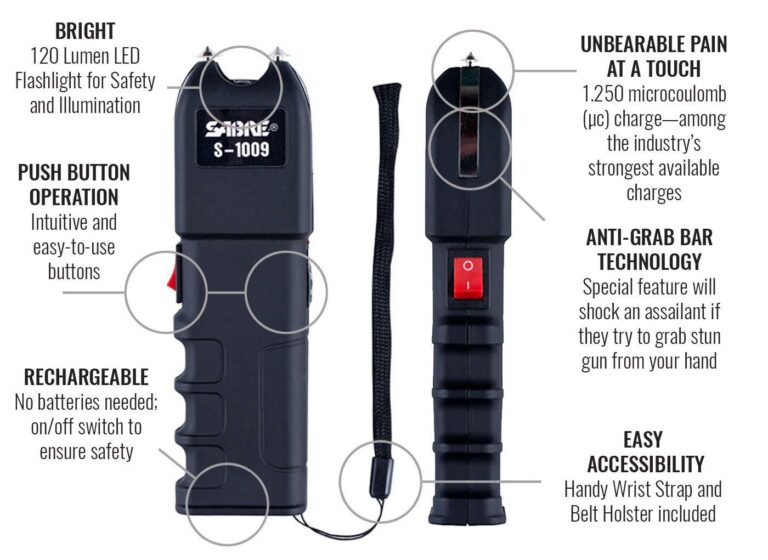Table of Contents
- Understanding the True Meaning of Voltage in Stun Guns
- How Voltage Affects Stun Gun Performance and Effectiveness
- Safety Considerations When Using High Voltage Stun Guns
- Choosing the Right Voltage Stun Gun for Your Personal Security Needs
- The Way Forward
Understanding the True Meaning of Voltage in Stun Guns
When discussing stun guns, the mention of voltage often leads to misconceptions. Many assume that a higher voltage rating directly translates to greater stopping power. However, the reality is more nuanced. Voltage in stun guns primarily indicates the potential difference required to initiate an electric arc that can disrupt muscle control temporarily. What truly matters is how the device delivers this voltage – the current (amperage) and pulse duration play a crucial role in its effectiveness. A stun gun with a voltage in the millions may look impressive on paper, but without sufficient current and well-timed pulses, it won’t deliver the incapacitating shock needed in self-defense situations.
Key factors to consider beyond voltage include:
- Current Output: The actual amount of electric current that passes through the attacker’s body is what causes temporary muscle paralysis.
- Pulse Frequency: How many pulses per second can determine the stun gun’s ability to maintain muscle disruption.
- Contact Time: Longer contact allows the device to deliver more cumulative energy, increasing its immobilizing effect.
Understanding these elements will help you choose a stun gun that is not just powerful in theoretical voltage terms, but practical and reliable in real-world defense scenarios.
How Voltage Affects Stun Gun Performance and Effectiveness
The voltage rating on a stun gun often grabs the spotlight, but its role in actual performance is more nuanced than just a high number on paper. While a higher voltage can enhance the stun gun’s ability to break through thicker clothing and improve the delivery of an electric shock, it doesn’t directly translate to increased stopping power or effectiveness. Instead, voltage serves as a measure of the electrical potential, enabling the stun gun to generate a powerful arc capable of reaching the target despite insulation or resistance. However, other factors like the current output (measured in milliamps) and the pulse frequency significantly influence how incapacitating the device truly is.
Understanding these details helps clarify why not all high-voltage stun guns are equally effective. A balanced combination of voltage and current ensures better results in disabling an attacker temporarily without causing permanent injury. Here are some key points to keep in mind:
- Voltage determines the arc length and ability to penetrate clothing.
- Current governs the intensity and duration of muscle disruption.
- Pulse frequency affects how the shock overwhelms the nervous system.
- Design quality impacts safety and reliability of the device.
Safety Considerations When Using High Voltage Stun Guns
When handling high voltage stun guns, it’s critical to recognize the inherent risks associated with their powerful electrical discharge. Improper use or accidental contact can lead to severe physical harm or unintended consequences, especially in close quarters. Always ensure the device is kept away from children and individuals with heart conditions or electronic medical implants, as the electrical shocks can interfere dangerously with their health. Equally important is to avoid using stun guns in wet or damp environments, where the risk of unintended electric shock or short circuits increases significantly, potentially leading to malfunction or injury.
To maintain safety while using and storing your stun gun, consider these best practices:
- Keep the stun gun in a secure holster or case to prevent accidental discharge.
- Regularly check the device for damage, especially to the electrodes and casing.
- Obey local laws and regulations regarding stun gun possession and usage to avoid legal complications.
- Only use the stun gun in scenarios explicitly requiring self-defense and with a clear understanding of how the voltage affects human physiology.
By adhering to these guidelines, you can ensure that your stun gun operates safely and effectively, minimizing risks while maximizing personal protection.
Choosing the Right Voltage Stun Gun for Your Personal Security Needs
When selecting a voltage stun gun, it’s crucial to prioritize your unique security requirements over merely opting for the highest numbers. Devices with extremely high voltages can deliver a more intimidating shock, but this doesn’t always translate to better protection for every user. Consider factors such as your physical environment, frequency of potential threats, and whether you prefer a device that offers ease of use, portability, or discretion. For instance, a stun gun intended for close-range defense might benefit from a balance between voltage power and manageable size, ensuring quick deployment when necessary.
Other aspects beyond voltage play a significant role in effectiveness. Pay attention to features like:
- Battery Life: Long-lasting cells ensure your device is ready when you need it most.
- Safety Mechanisms: Prevent accidental discharge while making the device accessible.
- Ergonomics: Comfortable grips enhance control during high-stress situations.
- Additional Features: Integrated flashlights or alarms can increase situational awareness.
Ultimately, the goal is to choose a stun gun that fits seamlessly with your lifestyle, providing confidence and control without compromising usability.
The Way Forward
Understanding the voltage of your stun gun is crucial not only for maximizing its effectiveness but also for ensuring your safety. By knowing how voltage impacts the device’s performance and what it means in practical terms, you can make informed decisions when selecting, using, and maintaining your stun gun. Always remember that while higher voltage can offer greater stopping power, responsible use and adherence to legal guidelines are paramount. Stay informed, stay prepared, and most importantly, stay safe.Check Our Other Blogs
- StunGun – Your Trusted Source for Stun Guns, Laws, and Self-Defense Tips
- PepperSprayLaws – Your Trusted Resource for Pepper Spray Information
- StunGunLaws – Your Trusted Guide to Stun Gun Legality and Safety





